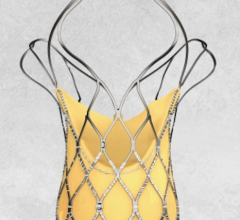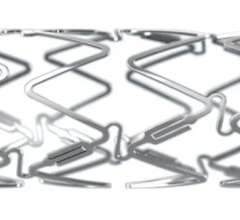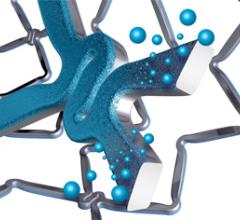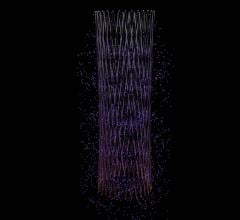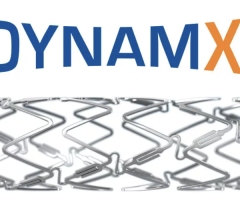September 10, 2007 - Four analyses of three-year follow-up data that were presented at the ESC Congress 2007 showed that the CYPHER Sirolimus-eluting Coronary Stent may be considered an appropriate alternative to bypass surgery in patients with blockages in two or more coronary arteries (multivessel disease).
Three of these analyses sought to assess the long-term impact of the CYPHER Stent when the patient with multivessel disease was also diabetic, the length of the blockage was more than 100 mm or the arterial blockage was located in a junction between a main artery and a side-branch artery, a type of blockage also known as bifurcation. A fourth analysis reported the overall incidence of stent thrombosis in the data set using the Academic Research Consortium (ARC) definitions.
In the United States, the CYPHER Stent is indicated forde novo lesions less than 30 mm in length in native coronary arteries between 2.5 mm and 3.5 mm in diameter. It does not have an approved indication for patients with multivessel disease, diabetes or blockages located at a bifurcation.
These analyses based their results on data from the Arterial Revascularization Therapy Study I and II (ARTS I and II Studies). The ARTS I Study was conducted in 1997 and compared the results of a bare metal stent to those obtained with bypass surgery. The ARTS II Study included 607 patients from 45 European centers treated with the CYPHER®Stent. Investigators compared the findings for these patients to those from the ARTS I Study, which included 605 patients treated with bypass surgery and 600 treated with a bare metal stent.
“These analyses contribute significantly to medical understanding of clinical outcomes for the CYPHER Stent in patients with multivessel disease, who remain one of the most complex patient populations with coronary artery disease to treat,” said Principal Investigator Patrick W. Serruys, M.D., Ph.D.,from Thoraxcenter, Erasmus Medical Center in The Netherlands, who presented one of the analyses at the congress.
In the subgroup analysis of diabetic patients (367 patients or 20 percent of the total ARTS I and II patient populations), clinical investigators found similar rates of freedom from major adverse cardiac and cerebrovascular events (MACCE) for the CYPHER Stent and bypass surgery out to three years of follow-up. This finding is significant as MACCE-comprised of death, stroke, myocardial infarction (heart attack) and the need for revascularization (re-treatment) of the blocked artery-at one-year follow-up was the primary endpoint of the ARTS II Study. Specifically, 72.1 percent of the diabetic patients who received the CYPHER Stent remained free of MACCE three years after the procedure, compared to 82.2 percent of the patients in the bypass surgery arm (p=0.09). Additionally, the CYPHER Stent performed significantly better than the bare metal stent arm during the same endpoint, as 52.7 percent of the patients who received a bare metal stent did not experience a MACCE event after three years. The difference between the CYPHER Stent arm and the bare metal stent arm reached statistical significance (p=0.0003).
Clinical investigators also reported no significant impact on MACCE when CYPHER Stents were implanted in patients with blockages that measured more than 100 mm in length (20 percent of the ARTS II patient population). According to this subgroup analysis, 75.8 percent of these patients remained free of MACCE out to three years of follow-up, compared to 82.5 percent of the patients who received CYPHER Stents measuring 100 mm or less in length (p =0.15).
A third analysis showed that implantation of the CYPHER Stent in bifurcations did not affect clinical outcomes. The rate of freedom-from-MACCE for patients who received a CYPHER Stent to treat a bifurcation (53.4 percent of the overall patient population) was 79.8 percent, compared to 81.5 percent when the implantation did not take place in a bifurcation (p=0.61). The clinical investigators also found that neither the type of bifurcation (true/substantial or partial) nor the stent implantation strategy (one- or two-stent implantation) significantly influenced MACCE outcomes. The freedom-from-MACCE rate for true bifurcations was 81.9 percent, compared to 78.1 percent for partial bifurcations (p=0.58). The one-stent implantation strategy produced a freedom-from-MACCE rate of 82.0 percent, compared to 79.3 percent for the two-stent strategy (p=0.60).
In addition, the ARTS II Study investigators reported stent thrombosis rates for the CYPHER Stent using the ARC definitions. The definite, definite/probable and definite/probable/possible stent thrombosis rates for the CYPHER Stent at three years were 3.3 percent, 5.3 percent and 6.4 percent, respectively. Stent thrombosis comparisons between the CYPHER Stent and the bare metal stent were not possible as ARC stent thrombosis rates for the ARTS I Study were not available and the ARTS I Study did not track stent thrombosis rates beyond 30 days. The protocol stent thrombosis rate for the bare metal stent arm was 2.8 percent at 30 days of follow-up, while the ARC definite definite/probable and definite/probable/possible stent thrombosis rates for the CYPHER Stent at 30 days were 1.0 percent, 1.5 percent and 1.5 percent, respectively.
In lieu of ARC stent thrombosis rates for the bare metal stent, the clinical investigators pointed out that the rate of myocardial infarction for the CYPHER Stent was significantly lower than that of the bare-metal stent (3.6 percent for the CYPHER Stent versus 6.8 percent for the bare metal stent, p=0.014). In addition, the mortality rate for the CYPHER Stent was numerically lower than that of the bare metal stent, although this difference did not reach statistical significance (3.0 percent for the CYPHER Stent versus 4.0 percent for the bare metal stent, p=0.33). These rates favored the CYPHER Stent in spite of the fact that the patients treated with the drug-eluting stent were significantly more complex than the patients treated with the bare metal stent.
For more information: www.cypherstent.com


 July 02, 2024
July 02, 2024 
